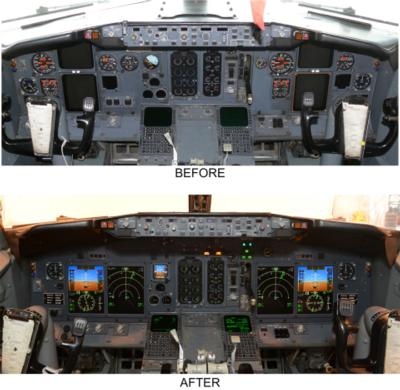Fri, Aug 10, 2012
STC Covers Installation On -300, -400, and -500 Models
The FAA has granted an STC to Innovative Solutions & Support, Inc. for the installation of its Flat Panel Display System (FPDS) on Classic B-737 aircraft.

The STC covers the B737-300/-400/-500 series aircraft and provides B-737 operators with a retrofit of their flight deck avionics with a modern pilot and copilot suite of high resolution multi-color LCD flat panel displays. The company says operators will benefit from improved dispatch reliability, logistics savings, and adaptability to future airspace requirements.
“Working with customers, we continue to expand our Flat Panel product line to additional aircraft types,” said Shahram Askarpour, president for IS&S. “With the launch of this program late last year, IS&S is able to deliver another certified program in to the market quickly and efficiently to support increasing customer demand for integrated avionics offerings.”
The receipt of the STC positions IS&S to pursue the more than 1,000 Classic B-737 aircraft with the need for Flat Panel Display System upgrades. The cockpit upgrade of the B737 replaces aging flight instruments and includes the installation of an Electronic Standby Instrument System (ESIS). The FPDS utilizes a common 10.4-inch display architecture that IS&S developed and certified, and that IS&S has installed on more than 160 B-757 and B-767 aircraft. “What makes this installation revolutionary is the short aircraft down time, while removing 10 net LRU’s and approximately 100 pounds, which can be less than 24 hours,” added Askarpour. The company will provide a complete turn key installation including installation at remote sites.
As it continues to deliver technology to support NextGen and SESAR requirements, IS&S has delivered multiple solutions which satisfy Communications, Navigation, and Surveillance/Air Traffic Management (CNS/ATM) needs. “The FPDS serves as the foundation of future technology by providing a true Forward Field of View (FFV) display of information and data to flight crews,” said Mike Glover, Director – IS&S Atlanta Region Director. “We are pleased to announce the B737 program certification and to deliver features and functions which operators need to support existing and emerging airspace requirements.”
The B737 FPDS is available for purchase and delivery through IS&S and offers an open architecture flat panel display system that allows operators to upgrade their aircraft while not replacing installed third party avionics. This approach allows the operator to select the best new equipment and minimizes the cost and down time of the upgrade.
(Image provided by IS&S)
More News
From 2023 (YouTube Version): Legacy of a Titan Robert (Bob) Anderson Hoover was a fighter pilot, test pilot, flight instructor, and air show superstar. More so, Bob Hoover was an i>[...]
Get The Latest in Aviation News NOW on Instagram Are you on Instagram yet? It's been around for a few years, quietly picking up traction mostly thanks to everybody's new obsession >[...]
Aero Linx: B-52H Stratofortress The B-52H Stratofortress is a long-range, heavy bomber that can perform a variety of missions. The bomber is capable of flying at high subsonic spee>[...]
Altimeter Setting The barometric pressure reading used to adjust a pressure altimeter for variations in existing atmospheric pressure or to the standard altimeter setting (29.92).>[...]
"Knowing that we play an active part in bettering people's lives is extremely rewarding. My team and I are very thankful for the opportunity to be here and to help in any way we ca>[...]
 Classic Aero-TV: Remembering Bob Hoover
Classic Aero-TV: Remembering Bob Hoover ANN FAQ: Follow Us On Instagram!
ANN FAQ: Follow Us On Instagram! ANN's Daily Aero-Linx (05.15.24)
ANN's Daily Aero-Linx (05.15.24) ANN's Daily Aero-Term (05.15.24):Altimeter Setting
ANN's Daily Aero-Term (05.15.24):Altimeter Setting Aero-News: Quote of the Day (05.16.24)
Aero-News: Quote of the Day (05.16.24)



